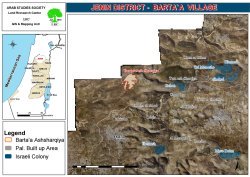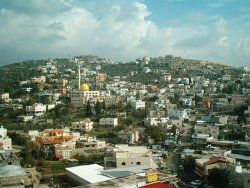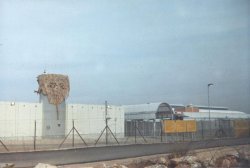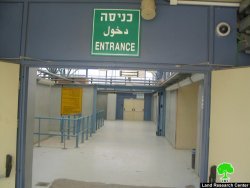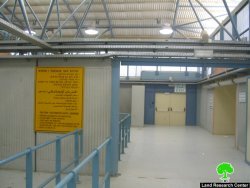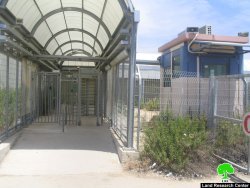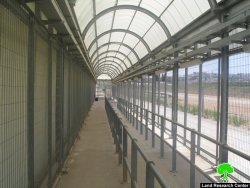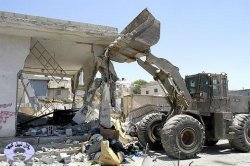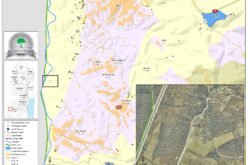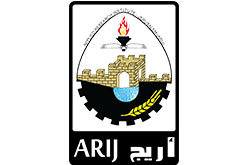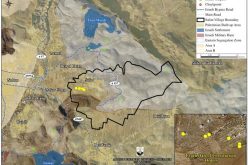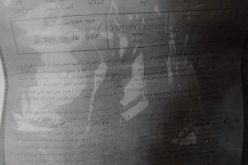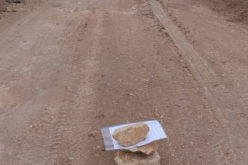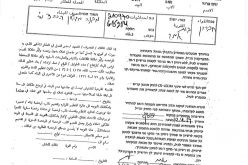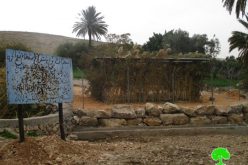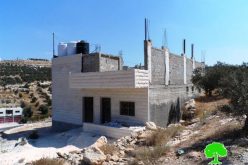The Israeli Occupation Army Issues Stop-Work Orders against a Number of Houses in East Barta’a
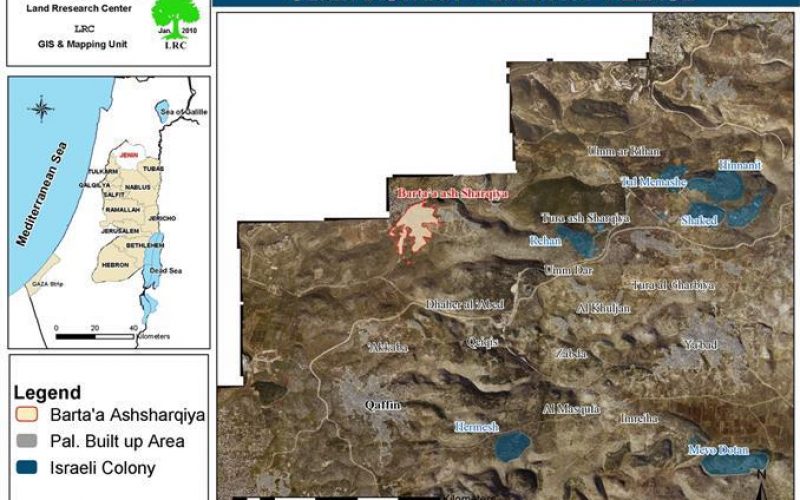
Violation: Issuing stop-work orders against number of structures in Barta'a ash Sharqiya.
Date: December 23, 2009.
Location: Barta'a ash Sharqiya- Jenin Governorate.
Details:
The so-called Construction and Organization Committee in the Israeli Occupation Government delivered 11 stop-work orders issued against agricultural and residential structures in Barta'a ash Sharqiya. The Committee justified the act by using the lame 'no permits' pretext since the constructions are located in areas classified 'C' according to Oslo Agreement.
The Committee gave the landlords a respite till January 21, 2010, the date of the hearing session in Beit El military court, to begin with the process of issuing permits.
General Information of the affected structures:
|
Landlord |
Area (m2) |
Number of structures |
Family members |
Type of structure |
|
Firas Qabaha |
220 |
2 |
1 |
Ready – uninhabited |
|
Omar Qabaha |
250 |
2 |
4 |
Under construction |
|
Rif'at Qabaha |
130 |
1 |
8 |
Under construction |
|
Samir Qabaha |
140 |
2 |
3 |
Under construction |
|
Na'el Qabaha |
150 |
1 |
1 |
Under construction |
|
Mohammad Sobhi Qabaha |
150 |
1 |
7 |
Under construction |
|
Raja Qabaha |
300 |
2 |
3 |
Under construction |
|
Sari Qabaha |
160 |
1 |
5 |
Ready – uninhabited |
|
Mohammad Zuhair Qabaha |
140 |
1 |
4 |
Barracks |
|
Ahmad Qabaha |
300 |
2 |
11 |
Under construction |
|
Yasir Qabaha |
400 |
1 |
7 |
Chicken farm |
|
Mohammad Yusuf Qabaha |
140 |
1 |
2 |
Barn |
|
Total |
2480 |
17 |
56 |
|
Misery of Barta'a ash Sharqiya:
Barta'a ash Sharqiya is located 30 km to the west of Jenin city and near the 'Green Line'. The closest Palestinina town is Ya'bad, 11 km to the east. The village is surrounded by three villages, Barta'a, Abdullah al Yonis, and Al Mintar. The Segregation Wall surrounds the eastern and southern parts of the village separating it from the West Bank. Its total area is 3500 dunums while the supposed area of the village is 21000 dunums. 3900 people inhabit the village; all of them belong to Qabah clan.
Picture 1: overview of Barta'a
The Armistice Line separates both parts of Barta'a ( which used to be one village). The village became divided into two since the drawing of the Green Line according to Rhodes which defined virtual borders between the areas occupied by the Israelis and areas that stayed under 'the Arabs control'. A small valley used to separate the two parts of the village. But now, members of the same clan who live in the same village live under different circumstances and are suffering from the consequences of the occupation and from political division.
Since the beginning of the construction of the Segregation Wall in 2002, the village was also separated from its Palestinian surroundings in the West Bank; the locals can reach other parts of the West Bank through a lonely gate called Al Rayhan. On May 16, 2007, the Israeli Occupation Army put the gate under a private security company responsibility. The employees of this company have no respect to the human dignity which leads them to deal with the Palestinians in a very humiliating and cruel way.
Picture 2: Al Rayhan Checkpoint
Mr. Ghassan Qabaha, president of Barta'a village council described the humiliating inspections conducted at the checkpoint. He said: 'The person trying to cross the checkpoint feels like he is leaving to another country. The process starts by stepping out of the car and waiting at the front door until he's allowed to step in. A voice from the speaker would, then, tell him/her to empty his pockets, take off his shoes and belt before passing through the metal detector. After several attempts, he/ she might be allowed to get to the so-called terminal then a journey of agony begins from that point on. The person stands in a line and then he is forced to put everything he's got on a checking device, then he/she himself/herself passes through a metal detector. When he/ she is done, another voice calls him to show everything he/ she has for manual inspection although it has been checked already. As for the ladies, they are forced to take off their veils and robes and they are not allowed to pass unless they comply. Soon afterwards, people are allowed to pass through another small empty room which leads to another small empty room with bullet proof glass windows that separates the passer from a security guard that orders him/her to empty his pockets and take off his shoes and belt again for manual inspection. People usually stay in that room for at least an hour. The security guards pay no respect whatsoever to the special cases, the sick or the elderly. They do not care about mixing between males and females, worst of all, they do not care about ordering females to take parts of their clothes off in front of other people as if they intend to humiliate and embarrass them. It should be mentioned that those small rooms have a capacity of 3 people; nevertheless, the guards do not hesitate to trap more than 6 people in one room for more than half an hour. Lastly, the person moves to the computer room where his ID and permit are checked before he walks through a 400 meters walkway to get to the cars on the other side'.
In case the locals tried to import some rations through the checkpoint, Mr. Ghassan said:' trucks loaded with supplies should inform the guards and receive preliminary approval of the security officials prior to getting to the terminal. Then they are ordered to get the truck to the checking spot and leave. Soon afterwards, workers unload the truck and then it is put under detailed inspection. Then, the workers are ordered to clear the way for the dogs that start smelling the goods leaving their saliva and dirt on the fruits, vegetables, etc. That is despite their claims that dogs will not be used for that purpose. After they're done, they call to the driver to move his car; this process needs at least an hour'.
Pictures 3+4+5+6: The crossing from the inside
It must be pointed that the Occupation Authorities forces the residents of the village to apply for permits to stay there. Despite the fact that the permits are issued for 24 hours, yet they are allowed to pass only from 5 AM to 9 PM everyday which contradicts the time allocated by the permits.
The Segregation Wall and the movement restrictions imposed on the residents deprive the people from their right to medical treatment since the restrictions pay no attention whatsoever to special cases making reaching hospitals and medical centers very difficult.
It must be noted that the Occupation Authorities prevent the entrance of ambulances to the village.
Furthermore, the Segregation Wall around the village negatively affects the educational process, teachers cannot move freely in and out of the village because of the restrictions imposed on movement. Many teachers were substituted with less qualified teachers living in the village.
In addition, the Wall devastated the commercial transactions between the village and its surroundings since the transportation costs increased rapidly. 80% of the shops in Barta'a were closed after the completion of the Wall. Also, the Wall separated the residents from their agricultural fields and most of them had to sell their lands to lose their only source of income.
Moreover, the Wall has affected the social fabric in the village; visits from outside the isolated village became almost impossible.
The Israeli Authorities have recently uncovered their intentions to build a new section of the Wall to separate Barta'a ash Sharqiya from its other side for 'security reasons'. The decision was made upon recommendations from Israeli Occupation Supreme Court in 2006. If this decision is carried out, many houses will be demolished for its sake like what happened while building the other parts of the Wall.
House Demolitions and Stop-Work Orders policy in Barta'a ash Sharqiya:
It is considered part of the Israeli policy that seeks emptying the lands from its inhabitants. 170 demolition or stop-work orders were issued in the village. In addition, 19 structures were actually destroyed. The Israeli Occupation Authorities claim that it was done because the houses were built on areas classified 'C' according to Oslo Agreement, whereas it is apparent that the real reason is putting more pressure on the inhabitants to force them to leave the area.
Picture 7: bulldozers demolishing a house in 2002 – Barta'a ash Sharqiya
Prepared by
The Land Research Center
LRC


